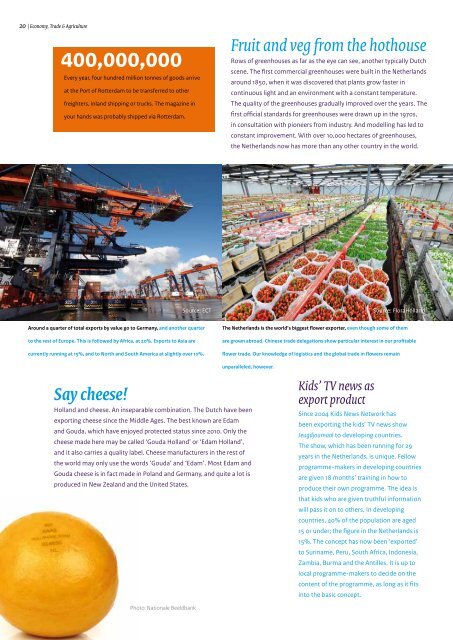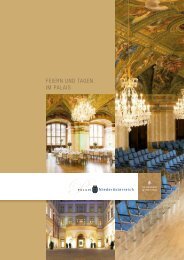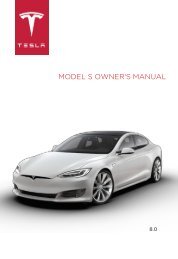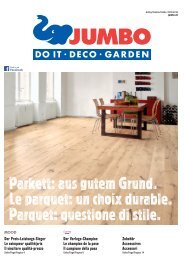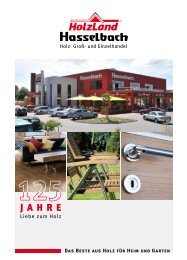Hello Holland!
Create successful ePaper yourself
Turn your PDF publications into a flip-book with our unique Google optimized e-Paper software.
20<br />
| Economy, Trade & Agriculture<br />
|<br />
21<br />
400,000,000<br />
Every year, four hundred million tonnes of goods arrive<br />
at the Port of Rotterdam to be transferred to other<br />
freighters, inland shipping or trucks. The magazine in<br />
your hands was probably shipped via Rotterdam.<br />
Fruit and veg from the hothouse<br />
Rows of greenhouses as far as the eye can see, another typically Dutch<br />
scene. The first commercial greenhouses were built in the Netherlands<br />
around 1850, when it was discovered that plants grow faster in<br />
continuous light and an environment with a constant temperature.<br />
The quality of the greenhouses gradually improved over the years. The<br />
first official standards for greenhouses were drawn up in the 1970s,<br />
in consultation with pioneers from industry. And modelling has led to<br />
constant improvement. With over 10,000 hectares of greenhouses,<br />
the Netherlands now has more than any other country in the world.<br />
Source: Keppel Verolme<br />
Illustrious shipbuilder from the Netherlands<br />
Industrialist and shipbuilding magnate Cornelis Verolme (1900-1981) was<br />
the Netherlands’ greatest shipbuilder. His yard, Verolme United Shipyards,<br />
built the biggest ships. One would break the record for biggest Dutch ship,<br />
the next for biggest ship ever built in <strong>Holland</strong>. For Verolme, it was always a<br />
matter of big, bigger, biggest. A man with great charisma, and great plans.<br />
These days Keppel Verolme (KV) is part of Keppel Offshore & Marine of<br />
Singapore, a global market leader in the building and repair of offshore<br />
platforms and specialist ships<br />
Source: ECT<br />
Source: Flora<strong>Holland</strong><br />
Photo: Rob Verhorst/<strong>Holland</strong>se Hoogte<br />
Source: NL Agency<br />
Around a quarter of total exports by value go to Germany, and another quarter<br />
The Netherlands is the world’s biggest flower exporter, even though some of them<br />
Every year, Dutch musicians’ foreign sales climb even higher. André Rieu, Tiësto and<br />
Machines for producing solar panels are not the first thing that comes to mind when<br />
to the rest of Europe. This is followed by Africa, at 20%. Exports to Asia are<br />
are grown abroad. Chinese trade delegations show particular interest in our profitable<br />
Ferry Corsten are top Dutch exports, and several Dutch DJs – Laidback Luke and<br />
you’re thinking about Dutch exports. But masses of these machines are being<br />
currently running at 15%, and to North and South America at slightly over 10%.<br />
flower trade. Our knowledge of logistics and the global trade in flowers remain<br />
Marco V, for example – are rising stars on the foreign club scene. Rock band Within<br />
exported to China. Dutch manufacturer OTB Solar has almost tripled its turnover as a<br />
unparalleled, however.<br />
Temptation is doing particularly well abroad.<br />
result of the huge demand.<br />
Say cheese!<br />
<strong>Holland</strong> and cheese. An inseparable combination. The Dutch have been<br />
exporting cheese since the Middle Ages. The best known are Edam<br />
and Gouda, which have enjoyed protected status since 2010. Only the<br />
cheese made here may be called ‘Gouda <strong>Holland</strong>’ or ‘Edam <strong>Holland</strong>’,<br />
and it also carries a quality label. Cheese manufacturers in the rest of<br />
the world may only use the words ‘Gouda’ and ‘Edam’. Most Edam and<br />
Gouda cheese is in fact made in Poland and Germany, and quite a lot is<br />
produced in New Zealand and the United States.<br />
Photo: Nationale Beeldbank<br />
Kids’ TV news as<br />
export product<br />
Since 2004 Kids News Network has<br />
been exporting the kids’ TV news show<br />
Jeugdjournaal to developing countries.<br />
The show, which has been running for 29<br />
years in the Netherlands, is unique. Fellow<br />
programme-makers in developing countries<br />
are given 18 months’ training in how to<br />
produce their own programme. The idea is<br />
that kids who are given truthful information<br />
will pass it on to others. In developing<br />
countries, 40% of the population are aged<br />
15 or under; the figure in the Netherlands is<br />
15%. The concept has now been ‘exported’<br />
to Suriname, Peru, South Africa, Indonesia,<br />
Zambia, Burma and the Antilles. It is up to<br />
local programme-makers to decide on the<br />
content of the programme, as long as it fits<br />
into the basic concept.<br />
Tulip mania<br />
A bunch of tulips in a Dutch shop will cost you around three euros these<br />
days. A far cry from the 17th century, when the tulip was all the rage. At<br />
the height of the ‘tulip mania’, the bulbs fetched eye-watering prices.<br />
One was sold for 5,400 guilders, which at that time would have bought<br />
you a magnificent canalside property in the heart of Amsterdam.<br />
2002 On 1 January 2002 the<br />
euro was introduced in 12 European Union<br />
member states, Monaco, San Marino and<br />
Vatican City. Many Dutch people were sad to<br />
say goodbye to their old currency, the guilder.<br />
Source: Rijksmuseum Photoservice


